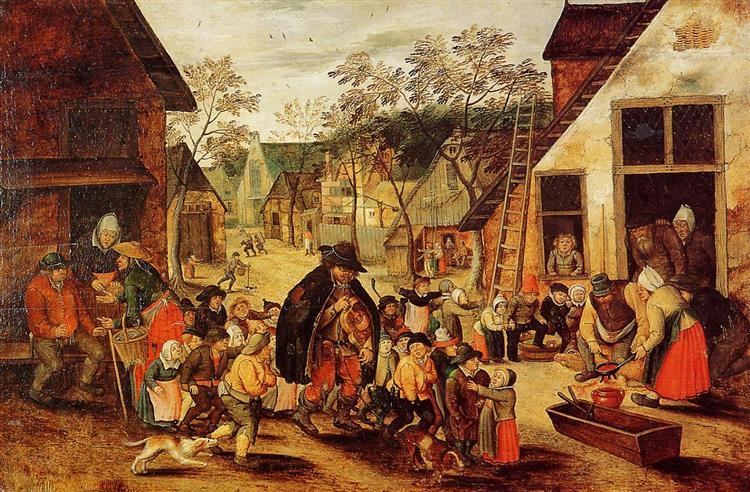Descrizione
Pieter Brueghel the Younger's painting "The Organ-Grinder", painted in 1608, is a work that encapsulates the very essence of everyday life at the time, through an approach that combines the simplicity of the everyday with the emotional depth representative of Flemish culture. As the son of one of the most renowned painters of the Northern Renaissance, Pieter Brueghel the Elder, the Younger took the reins of an artistic legacy that allowed him to explore and reinterpret his father's visual treasures, as well as offer new social commentary to his time.
The composition of The Organ Grinder is characteristic of Brueghel the Younger's work; we are presented with a setting in which the organ grinder is at the center, acting as a focal point that draws the viewer's gaze. The arrangement of characters and elements in the work reflects a rich and detailed visual narrative. Around him, several characters are grouped, each with expressions and attitudes that add a dimension of life to the scene. The variety of faces, from joyful to contemplative, facilitates a dialogue between art and viewer that transcends the mere act of observation.
The colours used in “The Organillero” strike a middle ground between a vibrant palette and a sober touch, a balance that confers vitality but also a sense of realism. Shades of terracotta, brown and green predominate, imbuing the work with a warmth that evokes a familiar environment. These tones not only build the atmosphere, but also reflect the time in which the work was created, a period marked by the search for a cultural identity in distinctive local elements.
Furthermore, the brushstroke technique shows meticulous attention to the details of the costumes, which should be interpreted not only as an aesthetic representation, but as a commentary on the social class of the characters depicted. The costumes, although simple, are loaded with insinuations about the subjects' economic status. Through the inclusion of the figure of the organ grinder, Brueghel the Younger hints at the importance of music in daily life, especially in the popular culture of Flemish cities, where itinerant musicians were a source of entertainment and colour in the streets.
An interesting aspect of the context of this work is its relationship to the rural and urban lifestyle of the Netherlands in the 17th century. During this period, many works of art began to reflect the interaction between social classes, and The Organ-Grinder is an example of how art can be a window into understanding the social dynamics of an era. Although the work is not free from elements of idealization, it is a testament to Brueghel's interest in human interactions and the beauty of the mundane.
It is important to mention that while the young Brueghel made variations on numerous works by his father, The Organ-Grinder maintains a sense of uniqueness that shows his own artistic approach. His depiction of everyday life, his ability to capture the complexity of human emotions through facial expression and the body, and his mastery of color and composition are elements that not only pay homage to his family heritage, but also chart their own path in the history of Flemish art.
"The work captures an atmosphere and a message that resonates even today," a reminder of the ties between art and life, as well as the invisible threads that unite generations through time, making "The Organ Grinder" an essential piece in the study of the art of Pieter Brueghel the Younger and, by extension, of the rich artistic tradition that illustrates life in the Low Countries.
KUADROS ©, a famous painting on your wall.
Hand-made oil painting reproductions, with the quality of professional artists and the distinctive seal of KUADROS ©.
Painting reproduction service with satisfaction guarantee. If you are not completely satisfied with the replica of your painting, we will refund 100% of your money.

